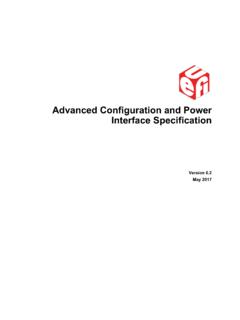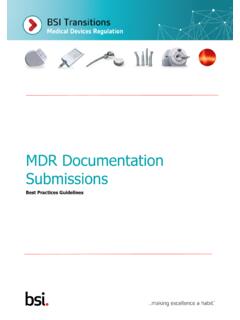Transcription of UEFI Firmware Security Concerns and Best Practices
1 Presented by UEFI Firmware Security Concerns and best Practices Fall 2017 UEFI Plugfest October 30 November 3, 2017 . Presented by Dick Wilkins, PhD & Jim Mortensen (Phoenix Technologies, Ltd.). UEFI Plugfest October 2017 1. Legal Stuff Copyright 2017 Phoenix Technologies Ltd. All rights reserved. PHOENIX TECHNOLOGIES LTD. MAKES NO REPRESENTATIONS OR. WARRANTIES OF ANY KIND WITH RESPECT TO THE INFORMATION. HEREIN DESCRIBED AND SPECIFICALLY DISCLAIMS ANY IMPLIED. WARRANTIES OF MERCHANTABILITY, FITNESS FOR ANY PARTICULAR. PURPOSE OR NON-INFRINGEMENT. FURTHER, PHOENIX. TECHNOLOGIES LTD. RESERVES THE RIGHT TO REVISE THIS. DOCUMENTATION AND TO MAKE CHANGES FROM TIME TO TIME IN. THE CONTENT WITHOUT OBLIGATION OF PHOENIX TECHNOLOGIES. LTD. TO NOTIFY ANY PERSON OF SUCH REVISIONS OR CHANGES. UEFI Plugfest October 2017 2. Contents Introduction Threats and Mitigation Guidelines Additional Concerns Validation Guidelines Next Steps Questions UEFI Plugfest October 2017 3.
2 Introduction UEFI Plugfest October 2017 4. This Content This content is an update of presentations at the 2014 and 2015. Spring UEFI plugfest events An earlier but more comprehensive version may be found at: UEFI Plugfest October 2017 5. Introduction UEFI Firmware is now widely deployed and has become a target for hackers and Security analysts/researchers Poor implementations affect the credibility of the UEFI. brand and market perception of all implementations As with all software implementations, there are going to be faults - (Phoenix is not perfect, even if we want to be). Phoenix would like to share some of our best Practices in the interest of raising the quality and Security of all UEFI. implementations UEFI Plugfest October 2017 6. Introduction Firmware is software, and is therefore vulnerable to the same threats that typically target software Maliciously crafted input Elevation of privilege Data tampering Unauthorized access to sensitive data Information disclosure Denial of Service Key Management Etc.
3 UEFI Plugfest October 2017 7. Introduction Firmware -Specific Threats Maliciously crafted input Buffer overflows to inject malware Elevation of privilege SMM code injection Data tampering Modifying UEFI variables (SecureBoot, Configuration, etc.). Unauthorized access to sensitive data Disclosure of SMRAM contents Information disclosure SMM rooted malware; secrets left in memory Denial of Service SPI flash corruption to brick the system Key Management Private Key Management for signed capsule updates UEFI Plugfest October 2017 8. Introduction We Are All At Risk! Disclosures regarding UEFI BIOS Security vulnerabilities look bad for the whole UEFI community! So how do we protect against UEFI Firmware attacks? UEFI Plugfest October 2017 9. Threats and Mitigation Guidelines UEFI Plugfest October 2017 10. Threats and Mitigation Guidelines Many organizations have provided disclosures of known issues and guidelines for developing more secure Firmware Examples come from Intel, Microsoft, Mitre, NIST, Linux distros and others.
4 Some are public and some are available only under NDA via direct communications with the involved companies UEFI Plugfest October 2017 11. Threats and Mitigation Guidelines Key areas for concern : Firmware Flash Regions UEFI Variables in Flash Capsule Updates SMM. Secure Boot Option ROMs UEFI Plugfest October 2017 12. Threats and Mitigation Guidelines Key areas for concern Firmware Flash Regions UEFI Variables in Flash Capsule Updates SMM. Secure Boot Option ROMs UEFI Plugfest October 2017 13. Threats and Mitigation Guidelines Malware injected into the address space is transient, and will be cleaned up on the next boot Malware injected into the Firmware flash regions is persistent and will run on every subsequent boot UEFI Plugfest October 2017 14. Threats and Mitigation Guidelines SPI Flash Exploit FV_MAIN. All PEIMs in flash are mapped to the address space as a DXE. Dispatcher part of FV_Recovery An attacker with write-access to flash can inject DXE Driver DXE Driver malware into the Firmware DXE Driver Malicious PEIMs can disallow flash updates, or cause Runtime destructive behavior ( , brick' the system) Hard drive Service Malicious DXE drivers can disable Security settings and install malicious code into the OS FV_Recovery resources SPI.
5 Malware in flash is persistent, and survives OS reinstall Flash FV_MAIN. and hard drive reformat Variable Store Address Space UEFI Plugfest October 2017 15. Threats and Mitigation Guidelines All flash Lock bits must be appropriately set prior to running any untrusted code If flash writes are protected via SMI. handlers, all SMM protection bits must also be appropriately set All Protected Range registers that block writes to flash address space must also be appropriately set and locked UEFI Plugfest October 2017 16. Threats and Mitigation Guidelines On resume from S3: All flash Lock bits must be appropriately set prior to running any untrusted code If flash writes are protected via SMI. handlers, all SMM protection bits must also be appropriately set All Protected Range registers that block writes to flash address space must also be appropriately set and locked UEFI Plugfest October 2017 17. Threats and Mitigation Guidelines On resume from S3: Scripts that re-initialize the platform must be secured against malicious modifications UEFI Plugfest October 2017 18.
6 Threats and Mitigation Guidelines Key areas for concern Firmware Flash Regions UEFI Variables in Flash Capsule Updates SMM. Secure Boot Option ROMs UEFI Plugfest October 2017 19. Threats and Mitigation Guidelines Ensure that all patches have been applied to Variable Services drivers Review custom implementations for similar vulnerabilities that have been patched in the core implementation UEFI Plugfest October 2017 20. Threats and Mitigation Guidelines Lock Authenticated Variable regions as early as possible Separate integral configuration and Security -based variables from those expected to be modified at runtime Reduce permissions to only what is needed Remove RT access for POST-time variables Set variables as Read-Only if they are not intended to be modified at runtime UEFI Plugfest October 2017 21. Threats and Mitigation Guidelines Key areas for concern Firmware Flash Regions UEFI Variables in Flash Capsule Updates SMM. Secure Boot Option ROMs UEFI Plugfest October 2017 22.
7 Threats and Mitigation Guidelines Secure Capsule Updates rely on proper signing, private key management, validation, and rollback protection NIST SP 800-107 provides guidelines for hash algorithm usage NIST SP 800-57 provides guidelines for key management NIST SP 800-147(b) provides guidelines for secure BIOS Updates NIST SP 800-193* provides general Firmware resiliency guidelines, including Firmware update mechanisms * draft May 2017 . UEFI Plugfest October 2017 23. Threats and Mitigation Guidelines Ensure that all patches have been applied to Capsule Update drivers Review custom implementations for similar vulnerabilities that have been patched in the core implementation Enforce Signed Capsule Updates Enforce Rollback Protection Use an HSM or Signing Authority for private key protection UEFI Plugfest October 2017 24. Threats and Mitigation Guidelines Key areas for concern Firmware Flash Regions UEFI Variables in Flash Capsule Updates SMM.
8 Secure Boot Option ROMs UEFI Plugfest October 2017 25. Threats and Mitigation Guidelines What is SMM? OS OS OS. Highly privileged processor mode Ring 3 Application Application Application Entered through a System Management Ring 2 3rd Party Driver 3rd Party Driver Interrupt (SMI). Processor saves its context, services the SMI, Ring 1 3rd Party Driver 3rd Party Driver then restores context and resumes OS Kernel SMM code has full visibility of all address Ring 0. space and devices Hypervisor Ring -1. Transition is transparent to the rest of the system Ring -2 SMM. UEFI Plugfest October 2017 26. Threats and Mitigation Guidelines SMM Mode OS Kernel SMM code has full access to all system memory and devices Hypervisor SMM code is not bound by OS Kernel or Hypervisor protections RAM. SMM code can read all of memory, modify memory contents, and even overwrite critical SMM Code system files and data on storage mediums SMRAM. Hard drive UEFI Plugfest October 2017 27.
9 Threats and Mitigation Guidelines SMM Mode Exploits OS Kernel During an SMI, all code runs with SMM-level privileges (Ring -2) regardless of where it resides Hypervisor Malware resident in SMRAM has full access to all system memory and devices RAM. Legitimate code in unprotected memory can be modified by Ring 0 malware SMM Code Modified code called by an SMI handler runs with SMM-level privileges (Ring -2) and gains full access to SMRAM. the system Non-SMM Code Hard drive UEFI Plugfest October 2017 28. Threats and Mitigation Guidelines SMM code must never call code outside of SMRAM because an attacker could have maliciously modified that code SMM code must validate input parameters from untrusted sources to prevent buffer reads/writes that extend into SMRAM. SMM code must copy input parameters and validate and use the copy, to prevent time- of-check-time-of-use (TOCTOU). vulnerabilities UEFI Plugfest October 2017 29. Threats and Mitigation Guidelines Enable Hardware Protections Lock SMRAM as early as possible Lock SMI control registers Enable hardware NX protections for addresses outside of SMRAM (if supported).
10 Enable paging NX protections for addresses outside of SMRAM. UEFI Plugfest October 2017 30. Threats and Mitigation Guidelines Key areas for concern Firmware Flash Regions UEFI Variables in Flash Capsule Updates SMM. Secure Boot Option ROMs UEFI Plugfest October 2017 31. Threats and Mitigation Guidelines UEFI Variables that contain Secure Boot settings must be locked and protected from unauthorized modification UEFI Plugfest October 2017 32. Threats and Mitigation Guidelines SMM code must never call code outside of SMRAM as this could allow bypass of Secure Boot protections UEFI Plugfest October 2017 33. Threats and Mitigation Guidelines All flash Lock bits, SMM protections, and Protected Range registers must be properly set to prevent bypass of Secure Boot protections UEFI Plugfest October 2017 34. Threats and Mitigation Guidelines Secure Boot Disable CSM. Set image verification defaults to secure values: DENY_EXECUTE_ON_SECURITY_VIOLATION.

















